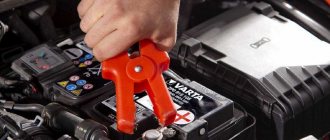How many volts should the generator produce?
In order for the car to work properly and not fail on the road, the car owner must constantly monitor the technical condition of his “four-wheeled friend,” while paying a lot of attention to the car generator.
If the unit fails, the battery will not be able to receive electrical recharging, and as a result, the car will work only from recharging the battery, the reserve of which will be enough for a short period of time. As soon as the battery supply is depleted, the engine will stop functioning and the car will simply stop, anywhere. In this case, the car owner will have to look for a lot of money to purchase a new generator, as well as to check and install it. But the process of monitoring technical serviceability, in which the most important thing is to monitor what voltage the VAZ-2110 generator should produce when driving, will help save money and know that the car will not let the owner down under any circumstances.
If you notice that the generator is working intermittently, then you need to check the functionality of the unit, especially since it is quite simple to carry out such a process yourself, taking into account the advice and recommendations of professionals in their field. However, before work, the car owner must familiarize himself with some rules that will help check the serviceability of the unit without damage.
Constant undercharging of the battery or its absolute discharge at the most inopportune moment is a headache for many car owners. One source of these problems may be the generator. But how to check it? Perhaps it's not his fault at all? Let's figure out together how much the generator must produce for the normal functioning of all car systems and maintaining the battery in a charged state.
It is traditionally believed that 13.5-14.5V should be supplied by the generator to the battery and this is absolutely enough to replenish the battery costs.
It is worth considering that using a battery with a higher power in a car than the manufacturer recommends also requires the installation of a more productive generating device.
It is necessary to take into account the load that the generator must withstand - it is calculated based on the maximum indicators of all electrical appliances and car systems.
Do not forget that the charging current from the energy-generating device will allow you to start the car in the cold season. In order to avoid problems with starting the car, we recommend purchasing generating equipment, the charge current of which will be approximately 10% of the capacity of the power source.
That is, a battery of 100 A/h requires a generator that can produce 10A. Please note that for many cars, 100 amp equipment will operate at its maximum capacity, because the power consumption of the automotive system is in the region of 80 amps. Therefore, the choice of a source generating energy must take into account both the battery capacity and network consumption.
The potential difference can be diagnosed in two ways - directly at the generating equipment and through the battery. The generator is directly connected to the power source with a thick wire, therefore, to check the level of potential difference, you can measure the voltage at the power source. To do this, you will need special devices - a voltmeter, multimeter or load plug.
The wires of the first measuring instruments are connected to the battery in any sequence. The plug must be connected to the battery terminals with strict observance of polarity. It is generally accepted that the normal voltage in the network should not be lower than 12 volts. At idle speed without turning on all the electrical appliances of the car, this indicator should be at the level of 13.5-14V. A drop in voltage values to 13.3-13.8 volts is considered acceptable.
At the same time, using conventional testing equipment, you can check the resistance of the generator elements - rotor, stator and diode bridge. Diagnostics of rotary equipment is carried out by its winding. It is necessary to connect the probes of the device with slip rings. If the multimeter gives readings from 2, 3 to 5.1 ohms, then this element is working. The current consumption of the winding should be within 3-4.5 amperes.
Its normal resistance is 0.2 Ohm. The diode bridge is checked by the presence or absence of resistance, the indicators do not matter. The only thing worth considering is that there should not be a zero dimension. Measurements are carried out in pairs - positive output and all plates on this side or minus and all elements.
We remind you that for normal charging of a car battery, the voltage supplied by the generator must be from 13.5 to 14 volts.
For correct operation of the car, it is necessary to regularly check the functionality of the car generator. If this unit fails, the battery will no longer receive main power. This state of affairs (when the car is “powered” only by the battery) leads to a rapid loss of power to the entire car.
Timely monitoring of the technical condition of the electrical source will allow you to avoid accidental failure of the element, saving your money and mental strength.
The breakdown of the power unit generating current is determined by one of the following signs:
- The light on the dashboard is constantly on (signal of insufficient current);
- The battery constantly runs out;
- electrical equipment malfunctions or does not work at all when the engine is turned on;
- burning smell from the engine compartment;
- the stator overheats;
- The NODE makes uncharacteristic sounds (for example, rustling).
Charging voltage of a car battery from a generator
A properly charged battery is an indispensable condition for a comfortable ride. In the cold season, it is especially important that the battery ensures reliable starting of the car engine. Modern cars, especially executive cars, have a battery charging control unit that monitors the main parameters of the process. There are no such devices in budget category vehicles. Experienced drivers perform this task independently. Let's look at how to have the most complete control over the battery charging process.
Causes of battery charging failure
The main parameter in the battery charging process is the charge current. Many parameters depend on its value.
Capacity replenishment speed
There is an opinion that for normal battery charging, the charge current should be 10% of its capacity, i.e. with a battery capacity of 50 Amp*hours, the charging current will be 5 Amps. Under such conditions, a completely discharged battery will gain its capacity up to its nominal value of 10 hours. Imagine, you were started from the wires of another car in the winter, and in order to fully charge the car battery, you need to drive the car for 10 hours in a row, that is, drive kilometers five hundred. It is believed that to replenish the battery charge to the nominal value, it is enough to drive 30 kilometers in a normal cycle, and in city traffic jams half that. That is, if your work is located more than 10 kilometers from home, this is enough not to worry about recharging the battery outside the car.
The case is different when work is close to home. You spent the capacity when starting the car, quickly drove to work, and then also home. After a week or two, your battery runs out. And not at all because there is something wrong with the car, it’s just the rhythm of the drive.
In this case, you should think about warming up the engine even in the warm season just to ensure that the battery is always in a charged state. Let's return to the charge current. If it is enough to drive a car 30 kilometers to fully charge the battery, and not 500, as in the example, therefore, the charging current of the car generator is not 5 Amperes, but much higher.
Battery life
The normal battery life is more than five years. Used cars imported from abroad have fully working seven- to nine-year-old batteries on board. There, however, the storage conditions for cars are different, and the temperature in winter is higher. There are three reasons for the low durability of the battery: violation of the battery charging regime, the quality of the battery, the human factor, in other words, laziness. Let's start with the first. If the battery is not charged to full capacity all the time, the plates undergo a sulfation process. Sulfation, or the formation of lead sulfate on the plates, can be compared to a stomach ulcer in humans, only in humans it can be treated, but a battery ulcer is practically untreatable.
There are various methods of complete discharge-charge, charging with pulsed currents. Maybe there is some percentage recovery, but if the battery is completely dead, then alas...
The quality of the battery depends on the manufacturer. Modern technologies only affect the increase in battery capacity while reducing the size and weight, respectively, the amount of lead. How to choose the best quality battery? If there are two different copies with the same capacity, starting current, cost, it is better to buy the one that is heavier, it has more lead, it will last longer. About the human factor. The biggest mistake car owners make is parking the car in the fall with the battery until spring.
If the battery spends several months in a discharged, not even fully charged state, and even in the cold with a reduced electrolyte density, it is unlikely to survive until spring.
If you periodically use the car in winter, then regularly (a couple of times a week) you need to start the car and warm it up for at least fifteen minutes, checking the charging voltage. If the car is not used in winter, it is better to remove the battery from the car, fully charge it and store it in a warm room , recharging once a month. During everyday use of the vehicle, it is necessary to regularly check the charging of the battery from the generator.
How to check battery charging from a generator
Checking the battery charging process is possible using the following methods:
- visual diagnostics;
- computer diagnostics;
- diagnostics using physical measuring instruments.
Visual control
Visual diagnostics can and should be done at least once a week. In the summer, it is imperative to monitor the electrolyte level either through the light or through the electrolyte topping holes. If the battery is maintenance-free, monitor the indicator window. When the recharging process is in progress (the charging current is too high, it is possible if the generator is faulty), the electrolyte boils away. This leads to an increase in acid concentration, corrosion of the plates, and an even greater increase in current and temperature. Video - charging voltage of a car battery from a generator, leakage currents and other checks: Such an avalanche-like process can destroy the battery in a couple of hours. Therefore, if you see any changes in the paint, foreign deposits, or a change in the shade of the battery case near one of the cans or electrolyte refill caps above the battery installation site, immediately determine the cause. If the control window of the battery during constant operation is not in the green zone, This means that the charging process is disrupted.
The visual method also includes monitoring the “battery” light on the dashboard. If it does not light up when the ignition is turned on, or does not go out after starting the engine, or flickers depending on the engine speed, then the battery charging process is disrupted.
Another tip for visually checking the charging process. In the dark, pay attention to the brightness level of the low and high beams when changing engine speed. This is best done by lighting a white wall. If the brightness increases with increasing engine speed, it means that the voltage-current regulator in the generator is not working properly, you need to check the generator.
Computer diagnostics
Computer diagnostics of cars equipped with a battery charge controller will give a complete picture of the operation of the generator, charge control unit, and battery performance level. But there are few such cars. Conventional computer diagnostics will provide information about the voltage of the on-board network. But it can also be obtained using a regular multimeter.
Diagnostics using devices
Experienced drivers remember that a garage tool always included a hydrometer and a load fork. A battery hydrometer is used to measure the density of the electrolyte. Normal density is from 1.23 to 1.28 g/cm3. The lower the temperature, the higher the density must be, otherwise the battery will freeze and fail. Using a load fork, you can identify a “rotten” can and repair it.
The most universal device for monitoring battery charging is a multimeter. How can I use it to check the battery charge?
First, before driving with a cold engine, measure the voltage at the battery. It must be at least 12.5 Volts. Turn on the ignition. In a normal case, the voltage will drop by 0.1 - 0.3 Volts, but it must still be at least 12.4 Volts to start the engine. Next, we start the engine. Check the voltage on the battery. In the case of a normal battery charging process, the voltage should be in the range from 13.5 to 14.5 Volts. If the voltage is higher, the battery is being recharged. This is possible in the following cases:
- the generator is faulty (voltage regulator, diode bridge, short circuit of the excitation winding);
- Lost battery capacity (aging, boiling, destruction of plates);
- violation in the battery charging control unit (if equipped).
If the voltage is less than 13.5 Volts, this indicates that the charge is weak, the generator voltage regulator is not working properly, and there may be problems with the wiring. If the voltage has not changed at all, on the contrary, it has decreased, it is necessary to check the generator or electrical wiring. Using a multimeter, you can charge current measurement. To do this, you need to disconnect the thick wire from the generator. Carefully insulate it (there are + batteries on it). Next, connect one multimeter probe to the free contact of the generator, the other to the positive of the battery.
Switch the multimeter to the “current measurement” mode to the 10 Ampere limit. Start the engine. The charging current will initially be large (more than 5 Amperes), then as the battery charges, it will decrease.
Checking the battery charge must be done at least once a month, and more often in winter. After all, at this time of year, the safety of the driver and passengers depends on the proper operation of the battery. Video - how to check battery charging from a generator: May be of interest:
Step-by-step check of the car generator regulator
The basic rules used when checking the generator voltage are simple, but mandatory for all car owners without exception:
- Under no circumstances should the functionality of the generator be tested using a so-called spark, that is, using a short circuit;
- It is not allowed to connect the device to the generator terminal “ ”;
- Welding work cannot be carried out in the body of the car if the wires are connected to the battery and generator.
It is important to consider the following points when checking voltage:
- measurements are carried out using special instruments called a voltmeter and an ammeter;
- checking the valves of the device is permitted if the voltage does not exceed 12 V;
- If the voltage test requires replacement of the wiring, you need to select identical wires both in cross-section and in length.
Before starting the test, make sure that all connections are working properly and that the device belt tension is correct.
It is not difficult to check what voltage a VAZ-2110 car generator should produce if the test is carried out in stages, and the car owner takes into account the advice of experts:
- Initially, you need to start the car engine, selecting medium speed and turn on the headlights. The car should remain in this mode for about 20 minutes. The indicator, as mentioned earlier, is measured with a voltmeter, the measuring scale of which is from 0 to 15 V, or with an ammeter.
- The voltage between the generator input “ ” and the mass of the unit is determined. If the generator is working properly, the indicator on the device scale should not exceed 14.5 V. If the device data is higher or lower than the established norm, then most likely you will have to replace the failed regulator.
- You can measure the voltage in another way, in which a voltmeter is connected directly to the battery. However, the resulting indicator will be accurate only if the car wiring is completely intact.
- You can also check the voltage using a special lamp, which is located on the dashboard; it is called a “control device”. In the time interval between turning on the ignition and starting the engine, the control light should be on, which allows you to control the voltage of the generator. If, when starting the engine, the lamp goes out and does not light up again, this will indicate that the generator is operating normally, without interruptions.
In other circumstances, for example, when the warning light is bright while the engine is running, you should check the tension of the alternator belt or the serviceability of the entire charging circuit. In some cases, a burning lamp indicates a malfunction of the entire device, in which case it will have to be replaced.
As was already said earlier, the maximum voltage that the VAZ-2110 generator produces should not exceed 14.5 V and not fall below 13 V. Finding out on your own what this indicator is is quite simple, taking into account the above recommendations. But if questions or difficulties arise during the work, you can, at a time convenient for yourself, watch a video about testing the generator, which is carried out by professionals in their field.
The main sign of a malfunctioning energy source is interruptions in U (voltage). In this case, check the functionality of the system and figure out how much the car’s generator transmits to charge the battery.
When testing, follow the advice of experienced car owners:
- prepare a multimeter;
- check whether the fasteners are connected correctly;
- check the quality of the belt tension;
- valves should indicate a current of 12 Volts (V) and below;
- When changing wiring, observe the cross-section diameter (the original and new ones ideally match).
If the element in question has received significant mechanical damage, we recommend entrusting its analysis to experienced auto repair shop employees.
How long should the generator charge? The algorithm for working with a multimeter looks like this: measure U at the battery terminals with the engine not running (the norm is 12.5-12.7 V). Start only the engine and repeat the measurement without load “at idle”. How many volts are supplied to excite the generator? “Healthy” indicators are from 13.8 V to 14.5 V (with a current strength of 80 to 140 Amperes).
The next step is to give maximum load by connecting additional equipment (headlights, radio, heated windows, etc.). With a working unit, the values under load will be from 13.7 V to 14 V. A value below 13 V is considered critical.
If you don’t have a multimeter, there is another way to diagnose at idle speed: turn on the engine, load it a little (for example, with the headlights on), remove the “-” terminal from the battery (you need a 10 key). The car, like the headlights, works stably - EVERYTHING is in order. If the car stalls or the headlights are dim, you need to further understand the issue.
How much does the generator deliver to the battery? If the battery is overcharged, you will notice characteristic signs: white streaks are visible on top of the battery (the electrolyte has boiled away, a possible cause is a malfunction of the regulator relay). The test is performed using a multimeter. See the charge when the internal combustion engine is running:
- 14.5 V - 14.8 V - normal, relay is OK;
- 15 V - 15.2 V - overcharge, the relay needs to be replaced urgently.
This breakdown should not be neglected, because the system can fail at the most unfortunate moment.
To prevent the electric generator, check:
- contacts;
- connections;
- wiring;
- whether the wire is disconnected before welding;
- belt tension;
- indicator on the dashboard (when it lights up, you should react quickly);
- Rectifier (if you suspect a problem with it, disconnect the battery);
- operability of the electricity source (by shorting the “ground” to the output);
- protection of electricity from any liquids.
The battery and generator work in parallel, withstanding high loads of different types: short-term, long-term and permanent. If it is important to know the power of all consumers, add the sum of the peak power indicators of all systems to the value required to recharge the battery. For ease of calculation, below is a table with approximate loads of all types.
Step-by-step procedure for checking the generator
- Turn on the ignition and make sure that all the dashboard lights are on.
- We start the car, and if the generator is operating normally, the battery warning light should go out.
- We wait until the car warms up to its standard operating temperature of 90 °C.
- When it warms up, it is necessary to load the network as much as possible. To do this, we turn on everything that is in the car, including heated mirrors, lights, music, etc.
- We take a pre-prepared multimeter and set it to the “voltage” check mode.
- Next, we call an assistant and ask him to keep the engine speed at idle (within 3500 - approx.).
- Using a multimeter, we connect its probes to the battery, and at the moment when all consumers are turned on, the readings should not fall below - 13-13.2 V.
If the readings are lower at such engine speeds, this will indicate that the generator is not producing the required amount of energy. And when they are normal, we continue testing with switched off consumers at the same speed. In this case, the multimeter readings should be about 14.5-14.7 V.
Checking the voltage supplied by the generator
After diagnosing the battery, we go directly to the generator using the same multimeter.
- When the car is started, we connect the probes to its terminals, and the voltage should be at least 14-14.3 Volts.
- Next, as the speed increases, we monitor the instrument readings, where the values should not change by more than 0.5 volts. If this is not observed, this will mean that the generator and voltage regulator are functioning correctly.
There is an excess of overvoltage in the network.
Now, having reliable information about how many volts the generator should produce, you will know for sure whether it is working or not. And if the readings differ slightly from the norm, then first of all you should pay attention to the malfunctions described below.
Troubleshooting
A lot depends on the operation of the VAZ 2110 generator. If it malfunctions, what can start the battery? And when it stops providing the required voltage, you have to urgently figure out what the reason is. But just by external signs you can determine that the generator is creating problems:
- The charging light starts flashing at low speeds;
- there may be a burning smell in the cabin;
- there are mechanical damages.
If a visual inspection does not bring results, you must:
- remove the plastic cover from the generator;
- check all electrical connections;
- Unscrew the diode bridge, as well as the voltage regulator relay with brushes.
Diodes are checked with a special tester. When they operate normally, the current will only flow in one direction. If the current flows in two directions or the diodes do not pass it at all, then the reason has been found.
The cause of poor performance may be the belt. If it is worn out, it can be seen immediately. If the generator winding “flies”, it is better to entrust the solution to this problem to a specialist.
What do you need to know about the operation of the generator on the VAZ 2110?
If the voltage supplied by the device is too weak, first you need to ring it. But before that, we suggest that you familiarize yourself with the main nuances in the operation of this unit. The operation of the generator on the “ten”, as on any other car, is based on the principle of electromagnetic induction. A magnetic flux passes through a copper coil, and at the moment it passes through it, voltage appears at the coil terminals. In terms of this voltage, it is proportional to the rate at which a given flow is changing.
In order for this flow to be transformed, an electrical voltage must be passed through the coil. In general, in order to obtain alternating current, a coil is needed, since the alternating indicator will be taken from it, as well as a source of alternating magnetic field.
On the “ten” the voltage source is the rotor, which constantly rotates while moving. This rotor includes a shaft, a pole pattern, and also slip rings. In addition, the VAZ 2110 generator also includes a stator - this element is necessary to create alternating current. The stator device includes a winding, as well as a core consisting of metal plates (the author of the video is Dmitry Pristrom).
Signs of a generator malfunction
What could be the problem with the generator when, when you turn on the ignition, the light flashes or does not turn on at all and the control devices do not function? You should check to see if the fuse located in the mounting block is ok. If there is a break in the power supply, the following may occur:
- the “O” wire with the wires from the mounting block to the devices is broken;
- there was a breakdown of the “GP” wire with the wires from the ignition switch to this unit.
If the battery is discharged, the generator voltage will not give the desired figure.
And the reason may lie in the fact that the control lamp has burned out, or perhaps the socket contacts are not pressed sufficiently against the printed circuit board. In this case, the lamp or faulty contacts are replaced.
You should look to see if there is an open circuit in the circuit connecting plug “D” of the generator and the devices. If this is exactly the case, then you need to look at the “KB” connections.
A lot also depends on the brushes if the VAZ 2110 generator does not produce the required power. They can wear out, freeze, the contact rings can oxidize, then you need to replace the entire brush holder along with the brushes. Oxidized parts are wiped with gasoline.
The terminals of the generator winding may become unsoldered from the slip rings, which need to be soldered or the surface of the generator rotor should be leveled.
A short circuit may occur in the valves, and the rectifier will have to be replaced. If the generator is noisy, it means there is a breakdown - the bearings are damaged; If the generator makes too much noise, you need to check the stator.
But when the generator 2110 does not produce 14.2 V, as it should, you need to start the engine - let it run for a while. In a few minutes, pressing the gas pedal, you need to increase the crankshaft speed to 3000 rpm. Now all functions should work, after which the voltage at the battery terminal is measured.
The voltage at this moment should be greater than 13 V. Other numbers indicate that there is a breakdown in the winding, or a short circuit may have occurred. You also need to check the voltage regulator with brushes; Maybe the reason lies in the oxidation of the generator winding rings.
The voltage regulator is checked by turning off all functions, but leaving the high beams on. Now you need to measure the voltage again, observing what it is now. Your mood will improve if the device shows the numbers 13.2-14.7 V.
The generator may be undercharged if the pulley is just spinning, and under heavy loads it begins to spin.
The normal output at idle is 14.2 V. Use a multimeter to take a measurement, but before that you need to check the input and output. Experienced craftsmen advise taking a welding cable, attaching the minus to the motor, and bringing the plus to the generator. If the result is negative, the generator needs to be changed.
In modern cars, breakdowns of the electrical system are one of the most common. A large number of electronics requires particularly careful monitoring of the operation and condition of the generator and battery, because their failure can immobilize the car. The most common signs of a generator malfunction are:
- battery indicator light on the instrument panel;
- unstable operation of the battery (its boiling over or undercharging);
- different intensity of headlights;
- extraneous sounds from the generator.
If you notice incorrect operation of the car, then perhaps the battery charging current from the generator is insufficient.
All malfunctions of electrical equipment, which includes the vehicle’s energy-generating device, are mechanical (deformation or breakage of fasteners, housing, malfunction of bearings, pressure springs, drive belt, etc.) or electrical (winding breaks, diode bridge malfunctions, burnout or wear of brushes , short circuits between turns, breakdowns, etc.).
Don’t write off a non-working generator: find out if there are repair kits and spare parts. Replace them if possible. If you cannot carry out repair work yourself, then take the generator to a workshop. Many craftsmen will be able to restore the unit at no extra cost and in the shortest possible time.
However, some breakdowns require the purchase of a new device that generates electricity. For example, a failing bearing that is soldered into the generator housing cannot be restored or replaced in most cases.
Remember that failure of this unit can be caused not only by wear and corrosion, but also by poor quality of elements and components; excessive load; external influence of salts, liquids, temperatures.
Troubleshooting
Lack of charging can be caused by a wide range of reasons, which we will talk about today.
These reasons include:
- Weak contacts;
- Winding breaks;
- Short circuit on the rotor housing;
- Interturn short circuits;
- Mechanical breakdowns;
- Closing the positive clamp on the body;
- Short circuit in the phase winding;
- Short circuit of the stator to the housing.
Let's look at these situations in more detail to determine the true cause of the breakdown specifically in your case.
Start by turning off all additional equipment in your car that is not included as standard - DVR, navigator, audio system, etc.
Next, we perform the following operations.
- Measure the current output when the vehicle is cold, not running and all life support systems are disconnected. If there is no return at all, that's good. But this rarely happens. Almost always on tens there may be insufficient contact, some kind of short circuit, due to which there is recoil, but it is small. It’s much worse if the recoil is impressive and leads to battery discharge in one night spent in a parking lot or garage.
- If everything is normal, there are no strong current leaks or they are insignificant, and the battery has retained its charge, then you can return all the devices to the places that were installed additionally.
- Recheck the recoil. If at the same time the instruments show an active leak, then the reason does not lie in the battery and is not related to the generator. The culprit of the problem is one of the additionally connected devices.
- If no recoil is observed, then you need to carefully inspect the generator.
- There are many sources of trouble that can lead to generator failure. These include:
- Insufficient contact between the rotor rings and brushes;
- There was a break in the excitation winding;
- An interturn short circuit has occurred on the field winding coil. In this case, the generator will hum and get very hot;
- The field winding closes to the rotor housing;
- The stator shorts to the housing;
- A break occurs in the stator phase winding;
- The diodes have broken through in the rectifier block, that is, the diode bridge;
- The plus is shorted on the body;
- Mechanical problems have occurred.
Next, we will take a closer look at each of the reasons presented above.
Disassembled unit
How much should the generator produce to properly charge the battery?
The battery in a car is an important element of the system, which is responsible for providing the car’s on-board network with electricity. The generator is used to charge the battery while it is active. Unstable operation of a device generating electricity causes a voltage drop in the network and failure to restore the capacity of the power source.
Normal generator performance means timely and complete replenishment of the battery charge level, which decreases under load. Checking the battery charge level from the generator is simple and can be done by the car owner himself.
Diagnostics of an automotive energy-generating device includes a visual inspection of the unit, its elements and related parts, as well as voltage and current measurements. At least twice a year, you should check the tension of the drive belt, excessive weakening of which leads to a decrease in the performance of the generator, and sometimes can lead to breakdown of the device.
Diagnostics of indicators such as voltage, current, resistance are also necessary twice a year. To carry it out, you will need special devices - a voltmeter, multimeter or load fork.
What methods can be used to increase generator voltage
To independently correct the voltage of the VAZ-2110 generator, you need to have on hand:
- Available device diagram.
- Voltage regulator from a domestic car.
- Voltage regulator from a foreign car.
- Necessary tools that may be required during the work process.
Having prepared everything you need, you should start upgrading the generator yourself, performing the work in stages:
- protection, called a tablet, is removed from the domestic regulator. At the end of the work, the body of the unit should be bare, only the brushes should remain on it;
- Using a generator from a foreign car (it is advisable to take a device with a voltage cycle of at least 15 V), connect its tablet to the bare body of the main component. The soldering method is used to connect the inputs;
- before connecting, you need to make sure that both ends are bent correctly, otherwise they simply cannot be positioned under the main body of the device;
- for additional fixation of the tablet to the body, it is recommended to use a bolt with a nut of the appropriate size;
- when soldering the inputs, be sure to ensure a tight fit to the base of the unit, and the tin layer must completely cover the tablet;
- To prevent the nuts from unwinding on their own when moving, they are sealed with a special compound, for example, sealant.
Other causes of low voltage
A small potential difference in the system is not always associated with a breakdown of the generator or a bad battery. If the diagnosis of these elements does not reveal any problems, then you should pay attention to the following:
- condition of the battery terminals - connection density and oxidation;
- electrical wiring problems - oxidation, violation of its integrity;
- output contacts to electrical appliances;
- correctly selected energy consumers.
Each contact must be tightly adjacent and intact, that is, there must be no formations (for example, sulfation) that will disrupt the flow of current. Incorrect connection of contacts leads to accelerated battery discharge even when the car is not running.
To improve the connection of the elements of the car's electrical system, it is necessary to clean all contacts and restore the integrity of the wires by replacing them or connecting them and wrapping them with insulating tape.
In conclusion, I would like to repeat that stable operation of the car requires constant monitoring of all elements, and the generator should attract special attention. The battery is charged from it and provides electricity to the entire car system. Pay attention to all elements: generator brushes, slip rings, voltage regulator, equipment winding.
The most correct measurements should be carried out when the battery is fully charged and in various modes. Remember that the manufacturer links the characteristics of the generator to the number of engine revolutions - they help produce a certain current.
Do you have experience diagnosing an alternator and solving problems in a vehicle's electrical system? Please share your experience and opinion with our readers in the comments. If you have questions about the topics covered, we will be happy to answer them.
If the symptoms described below appear, carry out diagnostics. You can do it yourself or take the car to a car service. To determine the cause of the failure, special equipment is needed. If you decide to figure it out yourself, master a multimeter tester.
Five possible sources of difficulty are described below:
- bearing wedge (lubricant is used up, sometimes the belt breaks - you will need to replace or rebuild the unit);
- the winding has burned out (a common cause is the reagents used to treat winter roads);
- brush wedge (cause - wear of graphite cores);
- the regulator relay is faulty (this element prevents the battery from overcharging and stabilizes the voltage);
- The diode bridge is broken.
Features of the circuit
The above is a general diagram of the circuit, without details, but it is enough to understand how everything works. Now about the features of battery recharging.
The generator cannot independently regulate the parameters of the generated electricity, so the output voltage from it varies, and in a significant range, it depends on the crankshaft speed and the load in the on-board circuit. That is, the battery is essentially constantly being recharged while the generator is generating electricity.
In order for the battery to accept a charge, you need to apply a voltage to it slightly higher than the nominal value of the battery itself. The input voltage on the battery differs on different cars, but in general, this figure is in the range of 13.9-14.5 V.
It is at this voltage that the battery can “take” a charge. If the voltage is lower, the battery will be undercharged, and if the voltage is higher, it will be overcharged. Both situations have a negative impact on the battery.
The generator produces a voltage with a high value, and in order to maintain it in the circuit within the required limits, a relay regulator is included in the circuit.
On some models, this element is included in the design of the generator and is combined with a brush assembly (the most common design) or is a separate unit (found, for example, on the VAZ of the classic family).
Normal voltage indicator in the VAZ-2110 generator
From the article you will learn what generator voltage is considered normal at idle and under load, how this parameter affects the service life of the battery.
To check the generator voltage, you need to start the engine and turn off the entire load. In this case, the multimeter should show 14.3 -15.5 Volts (see video at the end of the article). A deviation of 0.1 Volt in one direction or the other is allowed.
After this, it is necessary to connect consumers one by one and check the generator voltage.
Ideally, it should “drop” by about 0.2 Volts when you turn on each new load. In this case, the total U should not fall below the level of 12.8 Volts. Otherwise, the battery will be discharged.
To ensure the functionality of the power supply, it is recommended to perform a load test.
To begin with, remember that there are three types of voltage:
- Nominal - indicated in the operating instructions. It is 12 Volts. This figure is far from the actual U value.
- Actual. Here we are talking about the voltage parameter after installing, connecting and starting to use the car battery. On average, this parameter is 12.6-13.2 V (this was mentioned above).
- Under load. Here the voltage parameter supplied by the generator can change.
The presence of a load allows you to verify the health of the battery and generator.
A seemingly serviceable battery with an output of 12 V can drop significantly after switching on the consumers. During the testing process, an additional device is used - a load fork, which allows for an increased load on the battery.
If your battery capacity is 60 mAh, the load value should be 120 A. The connection duration is 3-5 seconds.
We can say that the power supply is working properly if the voltage does not drop below 9 Volts. If the parameter drops to 5-6 V, this indicates a complete discharge of the battery. After testing under load, the voltage should return to 12.2-12.4 V.
If a strong drawdown is detected, it is necessary to check the battery, and then repeat the experiment with the plug again. If there is no drawdown, we can talk about the health of the battery.
To check the generator, you can do the following: start the car, turn on as many consumers as possible, and then take a measurement. The voltage should be 13.5-14 V.
If it is lower, this indicates a failure of the generator. The lower critical limit is 13.0 V.
If the voltage of the car's generator is very low, do not rush to draw conclusions - make sure that the contacts on the battery are not oxidized. If so, rub them with sandpaper.
How to check the generator voltage on a VAZ-2114 battery?
The operating condition of the generator on the VAZ-2114 should be checked every 6 months (best before and after winter - approx.), because it is in winter that the electrical network experiences increased loads. The check must be carried out regardless of whether it is working or not.
The importance of checking the generator is high, because if it is not capable of delivering a charge of a certain power, then the battery will simply discharge and the car will not be able to start, and if the voltage is excessively high, then problems can arise directly in the wiring and circuit of the car.
Signs of a generator malfunction
If one or more of the following symptoms appear on your car, then the generator must be checked:
- There is extraneous noise or hum coming from the generator. The noise will indicate that the bearings have failed (in most cases the front one breaks - approx.). You cannot drive with such a breakdown, because its jamming can lead to failure of the entire generator after the destruction of the bearing.
- On the instrument panel, the battery warning light shines too brightly , even when the engine is not running - this will indicate an excess of energy in the network.
The lamp burns brighter than usual.
Important points
The voltage (U) and capacity of the car battery are the main parameters that need to be paid attention to when choosing and checking a power source.
The main purpose of the battery is to start the engine during the period when the car's generator has not yet been connected to work, and the battery is the only power source.
To eliminate operational problems, the car owner should know the following points:
- What does the battery life depend on?
- What should the voltage be (in normal mode, after starting the engine and under load);
- What causes the decrease in capacity during the cold season and other issues.
Let's consider these questions in detail.
Malfunctions
There are two main reasons why an alternator stops charging properly.
Cause
Peculiarities
This happens to those who like to install numerous additional equipment that is powered by a generator, that is, it requires electricity. These could be speakers, electric pumps, video devices, etc. A standard generator is not designed for such loads, and therefore loses efficiency
Battery and alternator mismatch
To ensure the operation of electrical equipment additionally installed on the car, many decide to install a more powerful battery with a standard generator. A mismatch in power leads to the fact that the generator ceases to provide proper charging to the more powerful battery. So he simply does not have enough resources for this
What charge does the generator produce?
Many people are interested in the question of how much a generator should produce for normal operation.
Here the parameters directly depend on the current state of the car.
- If the engine is cold and just turns on, then the voltage will normally be 14.1-14.4 Volts;
- If you check the voltage after long trips in traffic jams, then the generator will produce less, about 13.9-14.1V.
Most often, a short circuit occurs when the insulation between the turns in the stator coils is destroyed. At the same time, the generator gets very hot, it does not charge the battery enough, since this only happens at very high crankshaft speeds.
As with other short circuits, there is something wrong with the generator: it gets very hot, hums, and its power decreases. The test is carried out using a 220 V lamp. One terminal is placed on the core, the other on one of the winding terminals. If there is a short circuit, the lamp lights up. Repair consists of replacing defective coils.
What determines the shelf life of a battery?
Each manufacturer, after manufacturing a battery, sets a warranty period for its operation.
In addition to this parameter, there is an actual period that depends on many factors - timeliness of maintenance, compliance with operating rules, condition of electrical wiring and other points.
Due to the fact that battery maintenance conditions differ, the shelf life of the product also differs.
Car owners who use their car only in the warm season have the longest battery life. It's another matter when you need a car all year round, regardless of the outside temperature.
In such a situation, the battery life is reduced. This is also due to the fact that in the second case the driver can cover more kilometers.
The battery life is also affected by:
- Serviceability and correct operation of the generator and voltage regulator.
- Connecting additional equipment with a large rated current to the vehicle's electrical wiring.
- Operating mode. The batteries that last the least are those in taxis that travel a long distance throughout the year. In addition, such cars operate in frequent engine starting mode, which puts a load on the battery and generator. If the vehicle is actively used, the service life of the power source does not exceed 1.5 years.
Under normal operating conditions, when the car owner regularly checks the battery and carries out maintenance, the battery life is 4-5 years with a total mileage of 60-80 thousand kilometers during this period.
To avoid problems, it is advisable to periodically check the voltage of the generator and battery.
But the mentioned service life is not the highest, because with careful maintenance the battery can last up to eight years.
But you should know that sooner or later the battery will need to be replaced, because from the moment you start using it, the working plates gradually wear out. The more charge and discharge cycles a battery goes through, the faster it breaks down.
Practice shows that the key role is played by the generator, its serviceability and current voltage. That is why this aspect needs to be given key attention.
Basic malfunctions and search for their causes
As already mentioned, during normal operation of the electric generator, the light on the dashboard will light up at the moment of ignition, and after starting the engine (and, as a result, the generator), it will immediately go out.
Guided by the “behavior” of this light bulb, you can try to determine the cause of the malfunction in the on-board network:
- when the ignition is turned on, the light does not light up, there is no illumination of instruments and other light bulbs - there is a break in the network;
- at the moment of ignition, the light does not light up or lights up dimly - the battery is discharged;
- The light comes on very brightly and continues to glow when the engine is running - the battery is overcharged, there are problems with the voltage regulator.
In order to perform a full check of the generator, you need to:
- Turn the ignition key and make sure that all warning lights come on.
- Start the engine and see if the warning light goes out.
- After warming up the engine, turn on all electrical consumer devices to create the maximum load in the network.
- Set engine speed to 3,500 rpm.
- Connect the multimeter in DC voltage measurement mode to the battery and take a measurement (you can find out exactly how much the VAZ 2114 generator produces in the instructions supplied with the car. Nominally, the operating voltage on the battery when consumers are turned on should be about 13 volts).
- If the voltage of the VAZ 2114 generator is below 13 volts, then there are problems with current generation, and if, with consumers completely turned off, the voltage does not rise above 14.7 volts, then the voltage regulator has failed.
One good way to check the health of the generator is to listen to it. To do this, you should start the engine and listen carefully to the operation of the device - if a running generator makes loud sounds, then most likely its bearings have collapsed and will have to be replaced.
By the way, one of the reasons for the rapid wear of generator bearings is an over-tight drive belt - if the tension is correct, its lateral deflection when pressed with fingers should not exceed 1.5 cm.
For a deeper check of individual components of the generator, you will have to use a probe - a 12-volt light bulb with a power of 3 W.
The check is performed as follows:
- alternately connect the light bulb on both sides to each of the diodes in the presence of current from the generator. Since diodes are transparent only in one direction, the light bulb should not light up (if it lights up, then the diode is faulty);
- connect the probe to the generator brushes. When the voltage reaches 16 volts, the light should go out. If this does not happen or, conversely, the light does not even light up, then the voltage regulator has failed;
- perform a “continuity test” of the state of the stator windings (for this purpose it will be more convenient to use a tester). If it turns out that there is a short circuit, the stator will have to be replaced.
Thus, checking the functionality of the generator is a fairly simple task. The most important thing is to do it periodically to find faults as soon as they appear. This will help avoid more serious problems and malfunctions in the on-board network.











